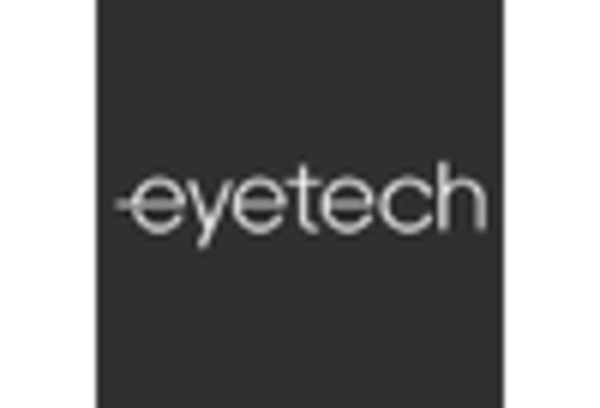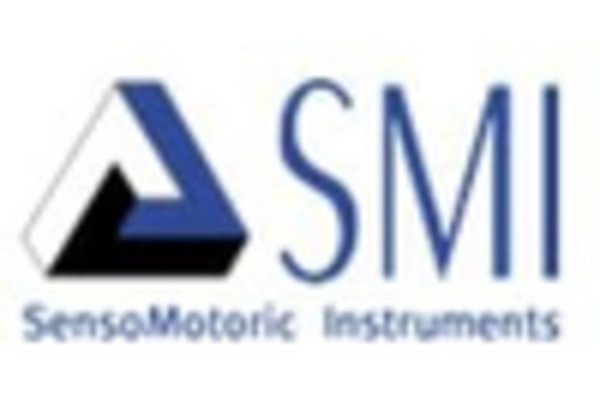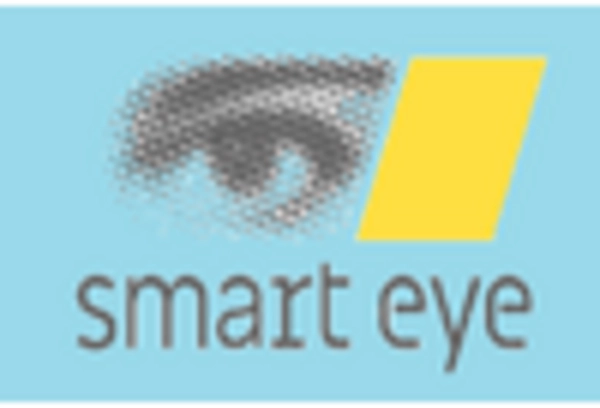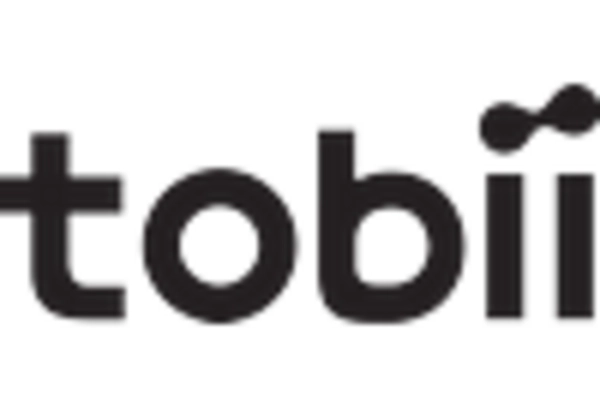Market Share
Introduction: Navigating the Competitive Landscape of Eye Tracking Technology
Eye-tracking is experiencing a period of unprecedented competition, driven by rapid technological development, changing legislation, and a rising demand for personalisation. The major players, such as the original equipment manufacturers (OEMs), system integrators, and newcomers from the field of artificial intelligence (AI), are competing to offer the best in terms of eye-tracking by introducing new features, such as advanced analytics and biometrics. In addition, the network operators are responding to the need for a more open system by integrating more IoT devices. These technological differentiators are becoming more and more important for the positioning of the market. In addition, the market is undergoing a significant geographical expansion, especially in North America and Asia-Pacific. In these regions, the strategic deployments are focused on the enhancement of the customer experience in sectors such as healthcare, transport, and retail. The C-levels and strategic planners will be required to have a clear understanding of these developments by 2024/25 to be able to take advantage of the opportunities that the changing landscape will offer.
Competitive Positioning
Full-Suite Integrators
These vendors offer comprehensive solutions that integrate eye tracking with broader analytics and user experience platforms.
| Vendor | Competitive Edge | Solution Focus | Regional Focus |
|---|---|---|---|
| Tobii | Market leader with extensive product range | Eye tracking hardware and software | Global |
| Nielsen | Strong analytics and consumer insights | Market research and audience measurement | Global |
| Seeing Machines | Focus on automotive and safety applications | Driver monitoring systems | North America, Europe, Asia |
Specialized Technology Vendors
These vendors focus on niche applications of eye tracking technology, often targeting specific industries or use cases.
| Vendor | Competitive Edge | Solution Focus | Regional Focus |
|---|---|---|---|
| SensoMotoric Instruments | Advanced research-grade eye tracking solutions | Research and clinical applications | Europe, North America |
| Smart Eye | Innovative solutions for automotive and aviation | Driver and pilot monitoring | Global |
| Cognixion | Focus on assistive technology for communication | Eye tracking for disabled users | Global |
| EyeTribe | Affordable eye tracking solutions for developers | Software development kits | Global |
| Pupil Labs | Open-source eye tracking technology | Research and development tools | Global |
Infrastructure & Equipment Providers
These vendors supply the hardware and foundational technology necessary for eye tracking applications.
| Vendor | Competitive Edge | Solution Focus | Regional Focus |
|---|---|---|---|
| Motions | Integration of motion capture with eye tracking | Motion and eye tracking systems | Europe, North America |
| Quantus Solutions | Customizable eye tracking hardware solutions | Tailored eye tracking systems | North America, Europe |
| Omron | Expertise in sensor technology | Eye tracking sensors and components | Global |
| Gazepoint | User-friendly eye tracking solutions | Eye tracking software and hardware | Global |
| EyeTech Digital Systems | Focus on assistive technology for communication | Eye tracking for accessibility | Global |
Emerging Players & Regional Champions
- Tobii Pro (Sweden): Tobii Pro is a Swedish company that specializes in eye-tracking solutions for research and usability testing. It has recently teamed up with several universities on advanced research projects. It complements established vendors by offering a more cost-effective and easy-to-use solution.
- EyeTech Digital Systems (USA): Focuses on eye tracking technology for assistive communication devices, recently secured contracts with rehabilitation centers, challenging established vendors by providing niche solutions for accessibility.
- SENSOMOTOR INSTURMENTS (Germany): Offers eye-tracking hardware and software for use in automobile and virtual reality applications. It has just completed a project with an automobile manufacturer and is a supplier to established companies that enhances the driving experience in simulators.
- Gazepoint (Canada): Gazepoint is a provider of low-cost eye-tracking systems for academic and commercial use. Recently it has added a mobile eye-tracking device to its product line, thereby challenging the established vendors by offering products that are more budget-friendly to the researcher and developer.
- Pupil Labs (Germany) develops open-source eye-tracking hardware and software, recently collaborating with research institutions in the development of new projects, complementing established vendors by developing a community-driven approach to eye-tracking technology.
Regional Trends: In 2024, the use of eye-tracking in Europe and North America rises, mainly due to the combination of AI and machine learning. The main applications are specialized in the fields of health, automobiles, and virtual reality. These markets are dominated by established companies, but new entrants, using their low cost and specialized solutions, are beginning to penetrate them. The regional champions are also improving their offerings through strategic alliances and research.
Collaborations & M&A Movements
- The purpose of the collaboration between Tobii and Microsoft is to integrate eye-tracking into the suite of accessibility tools from Microsoft, thus improving the usability for people with disabilities and strengthening their position in the assistive technology market.
- Apple acquired eye-tracking startup SensoMotoric Instruments to bolster its augmented reality capabilities, positioning itself as a leader in the AR space while expanding its market share in the eye tracking sector.
- Pupil Labs and Facebook collaborated to develop advanced eye-tracking solutions for virtual reality applications, enhancing user engagement and solidifying their competitive edge in the growing VR market.
Competitive Summary Table
| Capability | Leading Players | Remarks |
|---|---|---|
| Biometric Self-Boarding | Tobii, EyeTech Digital Systems | Tobii has implemented biometric self-boarding solutions in several airports, thereby improving passenger flow and reducing waiting times. EyeTech Digital Systems offers flexible solutions that can be easily integrated into existing boarding systems. |
| AI-Powered Ops Mgmt | SensoMotoric Instruments, Pupil Labs | SensoMotoric Instruments utilizes AI to analyze eye movement data for operational efficiency, with case studies showing improved resource allocation. Pupil Labs focuses on real-time data processing, allowing for immediate operational adjustments. |
| Border Control | Cognex, AOptix | Eye-tracking systems developed by Cognex, Inc., have been used successfully in high-traffic border crossings to enhance security checks. The AOptix system combines eye-tracking with biometric verification to improve the speed and accuracy of border checks. |
| Sustainability | FOVE, Vicon | FOVE's eye tracking technology is designed with energy efficiency in mind, reducing power consumption in devices. Vicon emphasizes sustainable practices in their manufacturing processes, appealing to environmentally conscious consumers. |
| Passenger Experience | Realeyes, EyeSee | Realeyes leverages eye tracking to enhance advertising effectiveness in airports, improving passenger engagement. EyeSee uses eye tracking for user experience research, providing insights that help improve overall passenger satisfaction. |
Conclusion: Navigating the Eye Tracking Landscape
The eye-tracking market will be highly competitive and fragmented by 2024, with both established and new players competing for market share. The market will be driven by increasing demand in North America and Asia-Pacific, as a result of the growth in the automation and artificial intelligence industries. Strategically, vendors will need to take advantage of developments such as data-driven analytics, automation for improved UX and sustainable practices to meet the evolving expectations of consumers. Strategically, as the market matures, it will be critical for market leaders to be able to offer flexible products that can be used across different applications in industries such as healthcare, gaming and retail. Strategically, this is where companies will need to focus to ensure they are able to respond to the complexities of this evolving landscape.















Leave a Comment